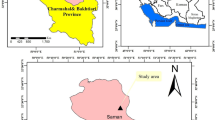Abstract
A green house pot trial was conducted to assess the impact of Prosopis afforestation on the productivity and fertility of degraded sodic soils in Haryana, India. Wheat (Triticum aestivum, L; cultivar HD 2329) plants were grown from seed on top soils collected from a chronosequence of 0, 5, 7, and 30-year-old Prosopis juliflora plantations established on highly sodic soils and a non-sodic reference soil collected from a local farm. The afforestation improved physical and chemical properties of surface soils by decreasing pH, electrical conductivity and exchangeable Na levels, and increasing infiltration capacity, organic C, total N, available P, and exchangeable Ca, Mg, and, K levels. The amelioration effect of the trees on top soil increased with duration of tree occupancy. Soil nutrient status under the 30-year-old plantation was higher than that of the non-sodic farm soil. The reduced soil sodicity and improved fertility contributed to higher germination, survival, growth, and grain yield of wheat plants grown on the Prosopis chronosequence soils, even surpassing the yield attained on the farm soil in the case of 30-year-old plantation soil. Sodium accumulation in the crop declined while N, P, K, Ca, and Mg uptake increased with soil plantation age reflecting the changing nutrient status of the rooting zone due to afforestation. Results confirmed that successful tree plantation may restore the productivity and fertility of highly degraded sodic soils.
Similar content being viewed by others
References
Abrol IP (1986) Fuel and forage production from salt affected wastelands in India. Reclam Reveget Res 5: 65–74
Ahmed P (1991) Agroforestry: a viable land use of alkali soils. Agroforestry Systems 14: 23–27
Asana RD and Kale VR (1965) A study of salt tolerance of four varieties of wheat. Indian J Pl Physiol 10: 26–35
Bajwa MS and Bhumbla DR (1971) Relationship between root cation exchange capacity and sodium tolerance of different crops. Plant and Soil 34: 57–63
Evans J (1992) Plantation Forestry in the Tropics. Oxford University Press, New York, 472 pp
Garg VK and Jain RK (1992) Influence of fuelwood trees on sodic soils. Can J For Res 22: 729–735
Gill HS, Abrol IP and Sharma JS (1987) Nutrient recycling through litter production in young plantations of Acacia nilotica and Eucalyptus tereticornis in highly alkaline soils. Forest Ecol Manage 22: 57–69
Gill HS and Abrol IP (1991) Salt affected soils, their afforestation and its ameliorating influence. International Tree Crop J 6: 239–260
Gupta RK, Bhumbla DR and Abrol IP (1984) Effect of soil pH, organic matter and calcium carbonate on dispersion behavior of alkali soils. Soil Sci 137: 245–251
Gupta RK and Abrol IP (99) Salt affected soils: their reclamation management for crop production. Adv Soil Sci 11: 223–288
Imo M. and Timmer VR (1992) Growth, nutrient allocation and water relations of mesquite (Prosopis chilensis) seedlings under differing fertilization schedules. For Ecol Manage 55: 279–294
Laura RD and Idnani MA (1971) Effect of addition of farm compost on the salt tolerance of wheat (Triticum aestivum) towards different alkali salts and their concentration. Agrochimica 15: 336–343
Lugo AE (1992) Comparison of tropical tree plantations with secondary forests of similar age. Ecol Monogr 62: 1–41
Maliwal GL and Paliwal KV (1967) Salt tolerance studies on some varieties of wheat (Triticum aestivum) and barley (Hordeum vulgare) at germination stage. Indian J Pl Physiol 10: 26–35
Mass EV and Grieve CM (1990) Spike and leaf development in salt-stressed wheat. Crop Sci 30: 1309–1313
Mass EV, Scott ML, Leland EF and Grieve CM (1994) Tiller development in salt-stressed wheat. Crop Sci 34: 1594–1603
Nicolas ME, Munns R, Samarkoon AB and Gifford RM (1993) Elevated CO2 improves the growth of wheat under salinity. Aust J Plant Physiol 20: 349–360
Pearcy RW, Eheringer J, Mooney HA and Rundel PW (eds) (1991) Plant Physiological Ecology. Chapman and Hall, New York, 48 pp
Piper CS (1957) Soils and Plant Analysis. Hans Publishers, Nicol Road, Bombay, 368 pp
Prinsely RT and Swift MJ (1986) Amelioration of Soils by Trees; a Review of Current Concepts and Practices. Commonwealth Science Council, London, 181 pp
Rasmussen WW, Moore DP and Alban LA (1972) Improvement of a solonetzic (slik spot) soil by deep ploughing, subsoiling and amendments. Soil Sci Soc Am J 38: 229–238
Sanchez PA, Palm CA, Davey CB, Szott LT and Russel E (1985) Tree crops as soil improvers in humid tropics. In: Cannel MGR and Jackson JE (eds) Attributes of Trees as Crop Plants, pp 327–358. Institute of Terrestrial Ecology, Natural Resource Council, Washington, DC
SAS Institute (1990) SAS User's Guide: Statistics. SAS Inst Inc, Raleigh, NC
Singh G and Singh NT (1993) Mesquite for Revegetation of Salt Lands. Bulletin No. 18. Central Soil Salinity Research Institute, Karnal, India, 19 pp
Singh NT (1991) Dry land salinity in the Indo-Pakistan subcontinent. Paper presented at the International Conference on Degradation and Restoration of Arid Lands. Lubbock, TX, Sept 24–25, 1991
Swarup A (1994) Chemistry of salt affected soils and fertility management. In: Rao DLN, Singh NT, Gupta RK and Tyagi NK (eds) Salinity Management for Sustainable Agriculture, pp 307. Central Soil Salinity Research Institute, Karnal, India
Szablocs I (1989) Salt Affected Soils. CRC Press Inc, Boca Raton, FL, 62 pp
Timmer VR (1991) Interpretation of seedling analysis and visual symptoms. In: van den Driessche R (ed) Mineral Nutrition of Conifer Seedlings, pp 113–134. CRC Press Inc, Boca Raton, FL
Tivy J (1990) Agricultural Ecology. Longman Scientific and Technical Co, John Wiley and Sons Inc, New York, 216 pp
Young A (1989) Agroforestry for Soil Conservation. CAB International, Wallingford, UK, 101 pp
Author information
Authors and Affiliations
Rights and permissions
About this article
Cite this article
Bhojvaid, P.P., Timmer, V.R. & Singh, G. Reclaiming sodic soils for wheat production by Prosopis juliflora (Swartz) DC afforestation in India. Agroforest Syst 34, 139–150 (1996). https://doi.org/10.1007/BF00148158
Issue Date:
DOI: https://doi.org/10.1007/BF00148158




